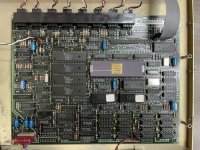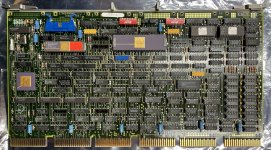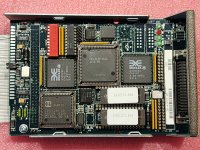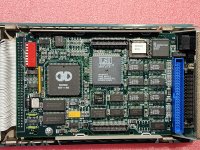Upcoming Events:
- VCF South West - June 14 - 16, Davidson-Gundy Alumni Center at University of Texas at Dallas
- VCF West - Aug 2 - 3, Computer History Museum, Mountain View, CA
- VCF Midwest - Sept 7 - 8 2024, Schaumburg, IL
- VCF SoCal - Mid February 2025, Location TBD, Southern CA
- VCF East - April 2025, Infoage Museum, Wall NJ
-
Please review our updated Terms and Rules here
You are using an out of date browser. It may not display this or other websites correctly.
You should upgrade or use an alternative browser.
You should upgrade or use an alternative browser.
Could not resist, the sound of a 68000 CPU, hello RF72
- Thread starter Schroeder
- Start date
gslick
Veteran Member
The RF72 is controlled by a 68000/16 CPU. In have the impression that DEC liked the 68000 CPU on I/O devices. Beside the HSD10 having a 286 CPU. The TK50 Controller a 80186.
The HSD05 uses a 286 CPU, in particular a Harris CS80C286-20.
The HSD10 uses an LSI Logic LR33310MC-33 CPU, with a MIPS R3000 compatible core.
saipan59
Experienced Member
It may be true (liking 68K), I don't know. I worked in Storage since 1981, and all of the storage controllers I was familiar with in the early 80's used a 2901 bit-slice (with dual sequencers, so that one thread handled the Host I/O, while the other did the disk I/O). Specifically: RC25, UDA50, KDA50, KDB50, KDM70, HSC50, HSC70. [Maybe the HSC had an MPU doing stuff like console I/O??? Don't remember...] The next generation of high-end controllers (HSZ and HSG series, etc.) used PowerPC chips.The RF72 is controlled by a 68000/16 CPU. In have the impression that DEC liked the 68000 CPU on I/O devices. Beside the HSD10 having a 286 CPU. The TK50 Controller a 80186.
Pete
AK6DN
Veteran Member
DELUA unibus ethernet controller (single hex board follow on to the two hex board DEUNA) uses an MC68000 as the controller CPU. The DEUNA used a T11.
saipan59
Experienced Member
RQDX is also a T-11.DELUA unibus ethernet controller (single hex board follow on to the two hex board DEUNA) uses an MC68000 as the controller CPU. The DEUNA used a T11.
Pete
AK6DN
Veteran Member
Trivia fact. Back when I was at DEC in the early 80s we wanted to use the just released/announced MC68000 as a graphics controller CPU. We had just been out to Stanford and visited Prof Forest Baskett and his grad student Andreas Bechtolsheim working on the 'SUN' terminal project that did all this fancy BitBLT graphics manipulations. We wanted to build a 68K based raster bit mapped graphics engine to put into the VAX-730 and create an engineering workstation with a graphics console. To make a long story shorter, Gordon Bell and the engineering committee nixed the idea. We could not use a 'foreign' ISA in a DEC system. So we had to build our own 16b custom microcoded CPU that took a whole hex board by itself, instead of just plopping down an MC68000 chip. Shortly after this I left DEC and went to Apple in 1982.
Funny thing is DEC R&D could use the MC68000 CPU and did, putting it into a graphics controller with a full page raster display. DEC later shipped that as a product in 1984.
Ref: http://www.bitsavers.org/pdf/dec/graphics/ED-26109-51_VAXstation_100_Technical_Summary_1984.pdf
As I said in the prior post they also then put the MC68000 in the DELUA unibus etherNet controller.
Funny thing is DEC R&D could use the MC68000 CPU and did, putting it into a graphics controller with a full page raster display. DEC later shipped that as a product in 1984.
Ref: http://www.bitsavers.org/pdf/dec/graphics/ED-26109-51_VAXstation_100_Technical_Summary_1984.pdf
As I said in the prior post they also then put the MC68000 in the DELUA unibus etherNet controller.
gslick
Veteran Member
Ah, interesting, I had my HSD05 open and I assumed it was the same as my HSD10 just without cache.The HSD05 uses a 286 CPU, in particular a Harris CS80C286-20.
The HSD10 uses an LSI Logic LR33310MC-33 CPU, with a MIPS R3000 compatible core.
cchhrriiss11
Experienced Member
DEC Liked to use the 68k with networking devices... I've got a collection of DECNet stuff, for example, the DECServer 100 and 200 used 68k chips (ceramic of course!):
DECServer 100:

DECServer 200:

Of course, the DELUA:

I still think DEC had the absolutely best board layout designs in the industry (by a long shot), even both of these boards are works of art.
-Chris
DECServer 100:

DECServer 200:

Of course, the DELUA:

I still think DEC had the absolutely best board layout designs in the industry (by a long shot), even both of these boards are works of art.
-Chris
Last edited:


